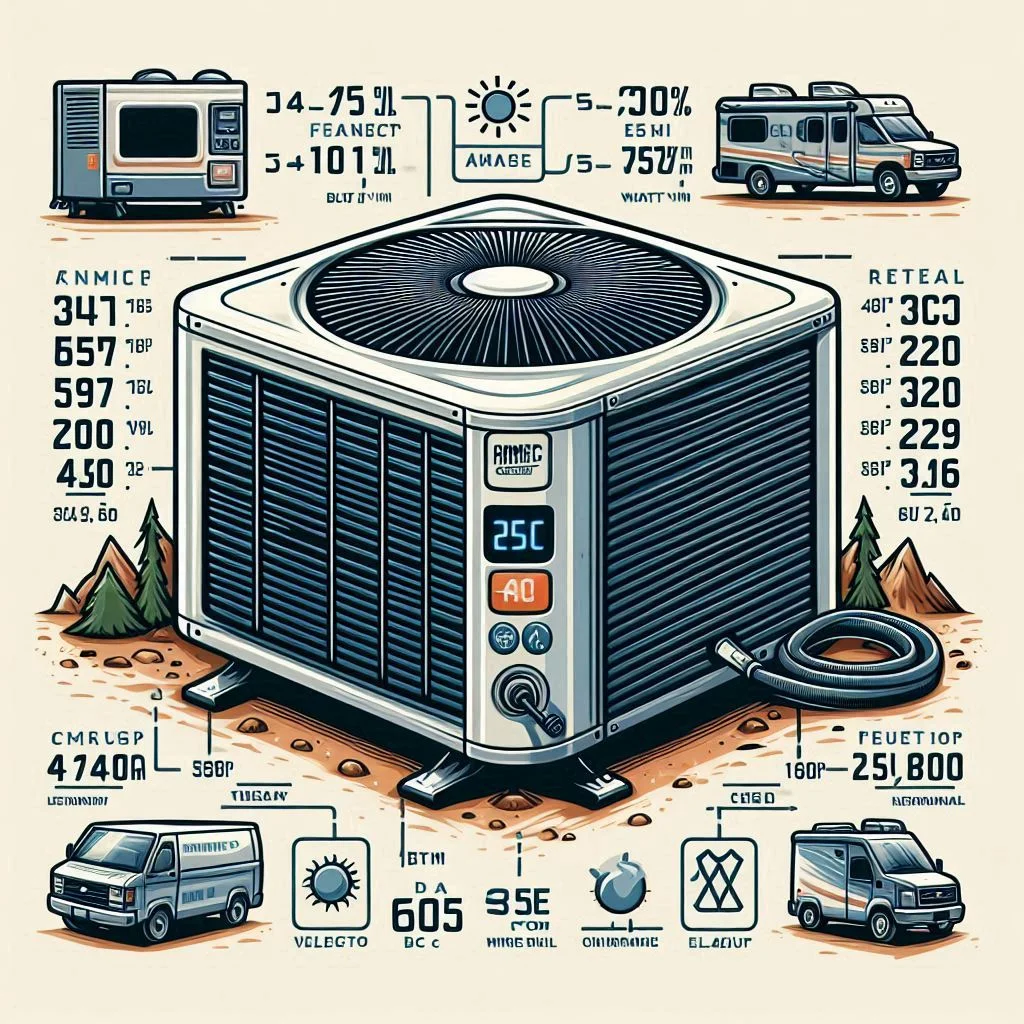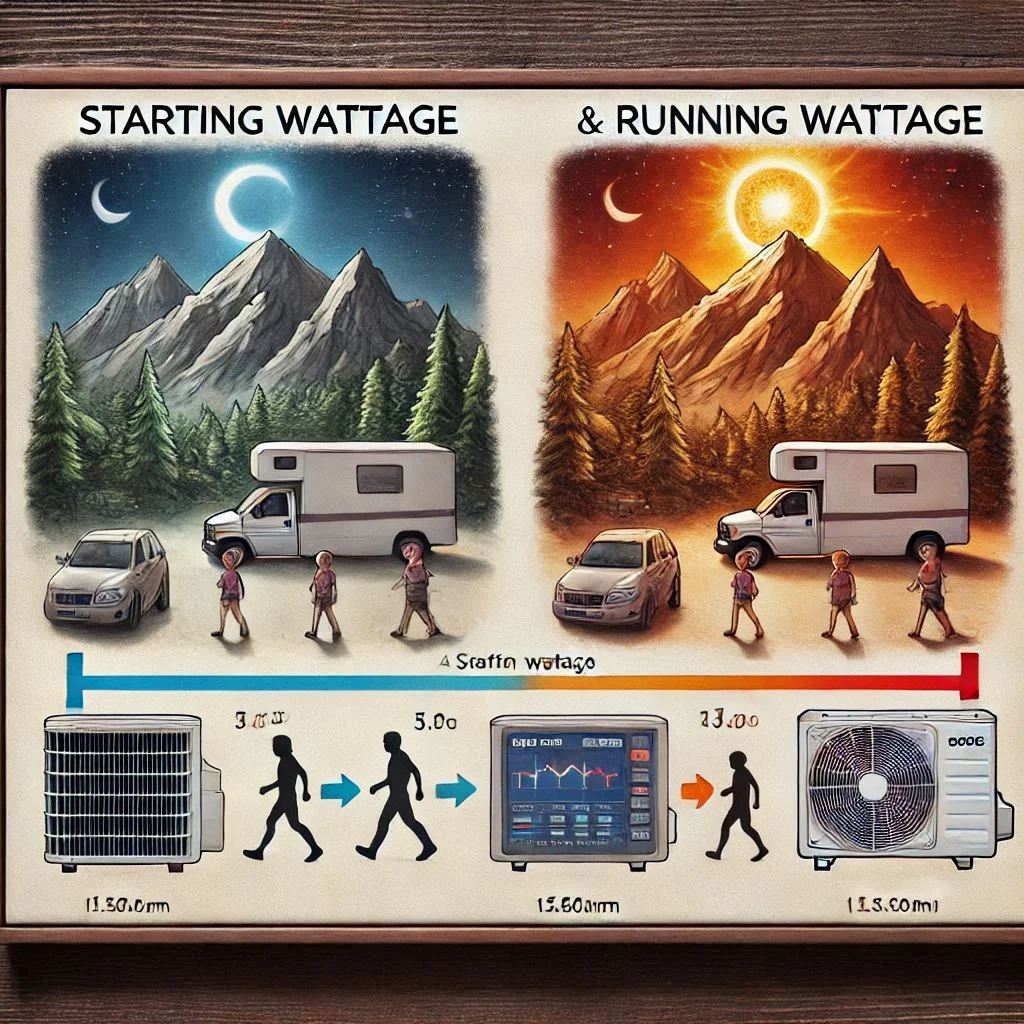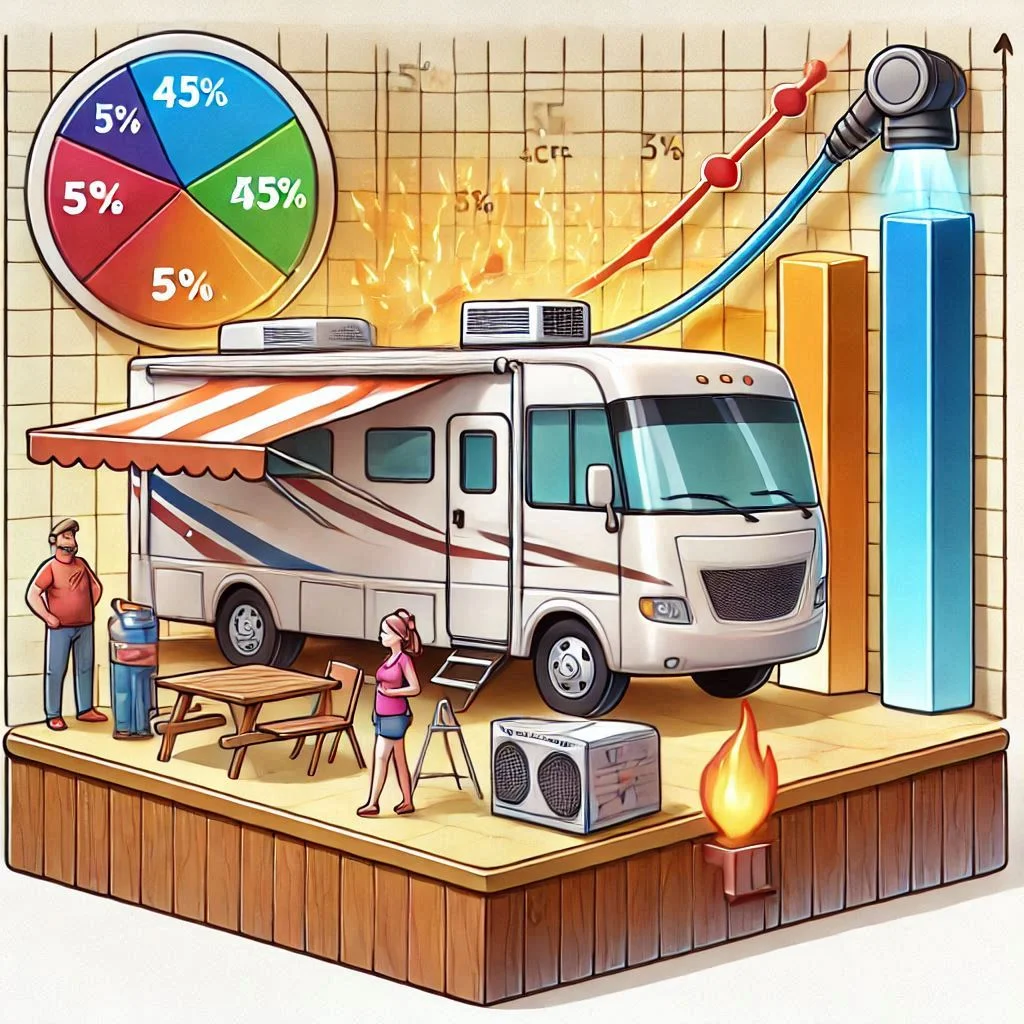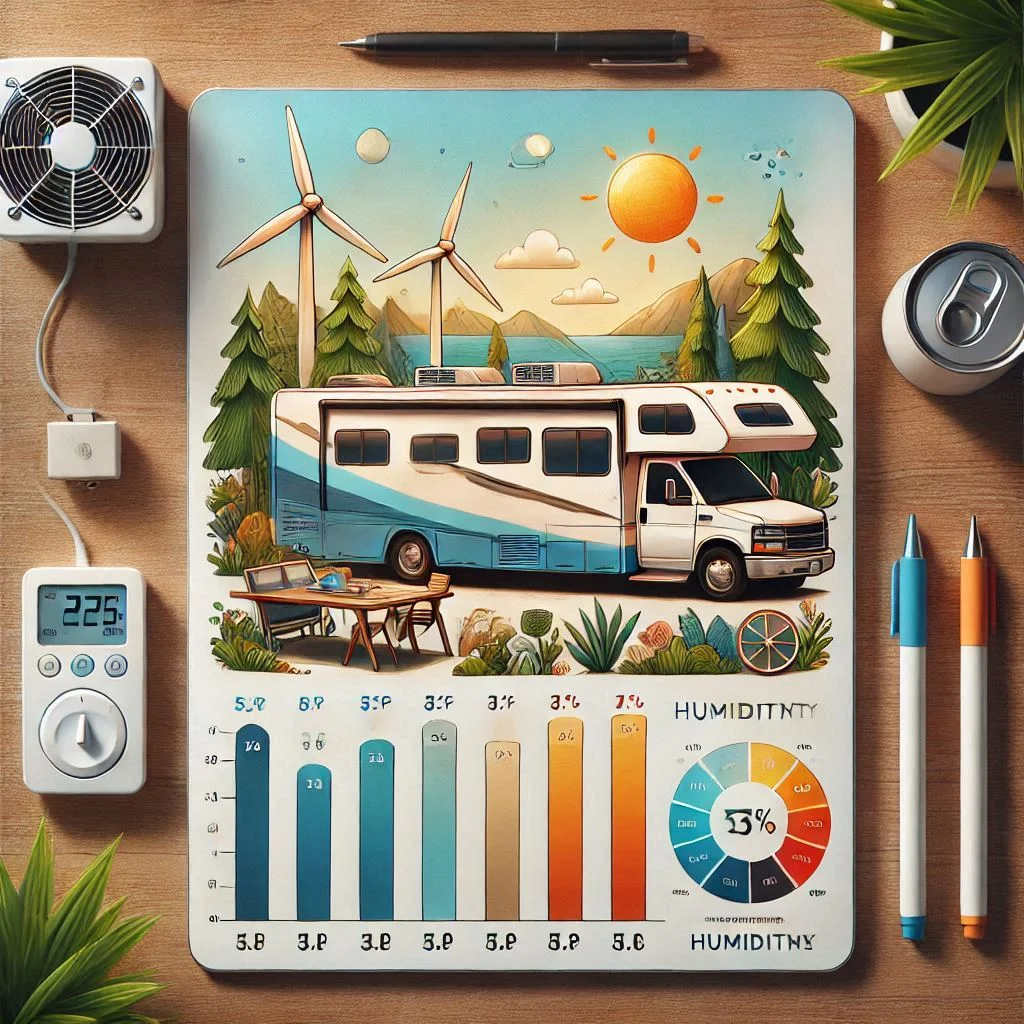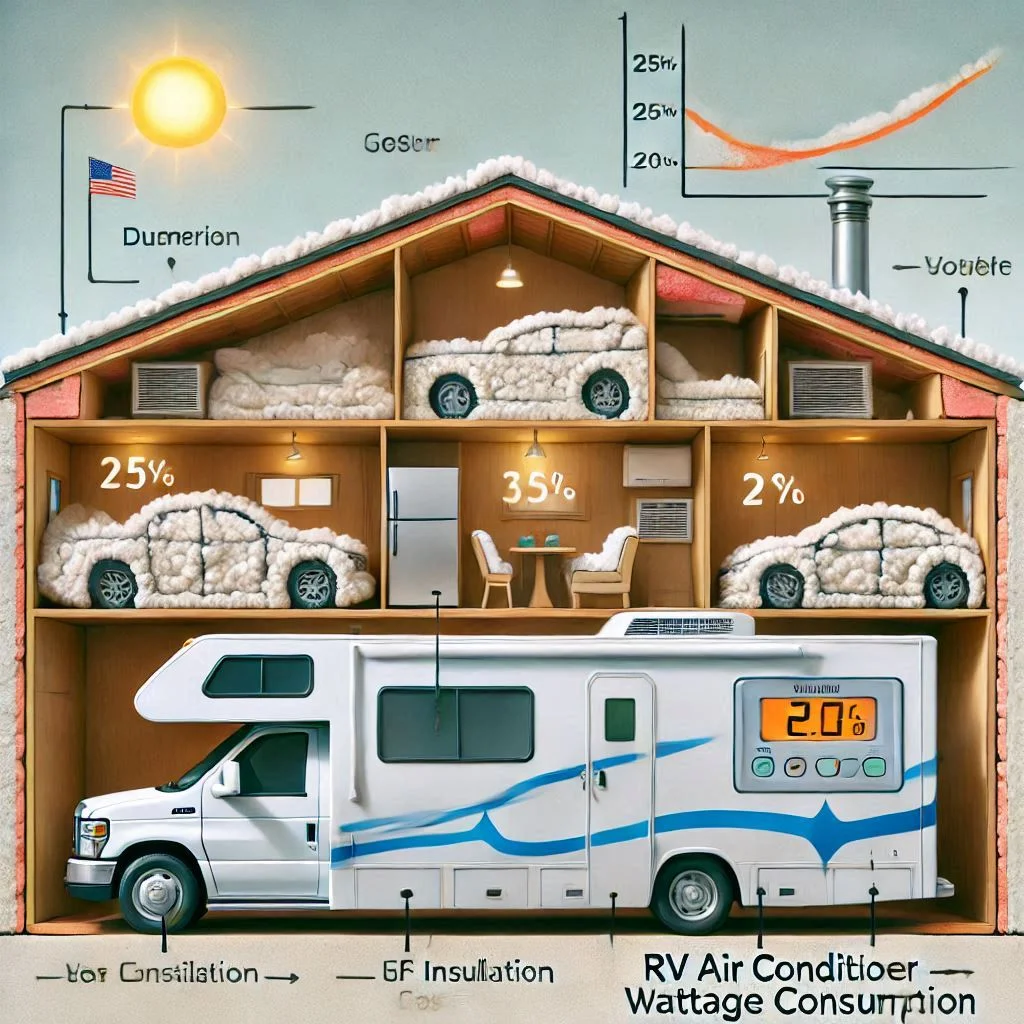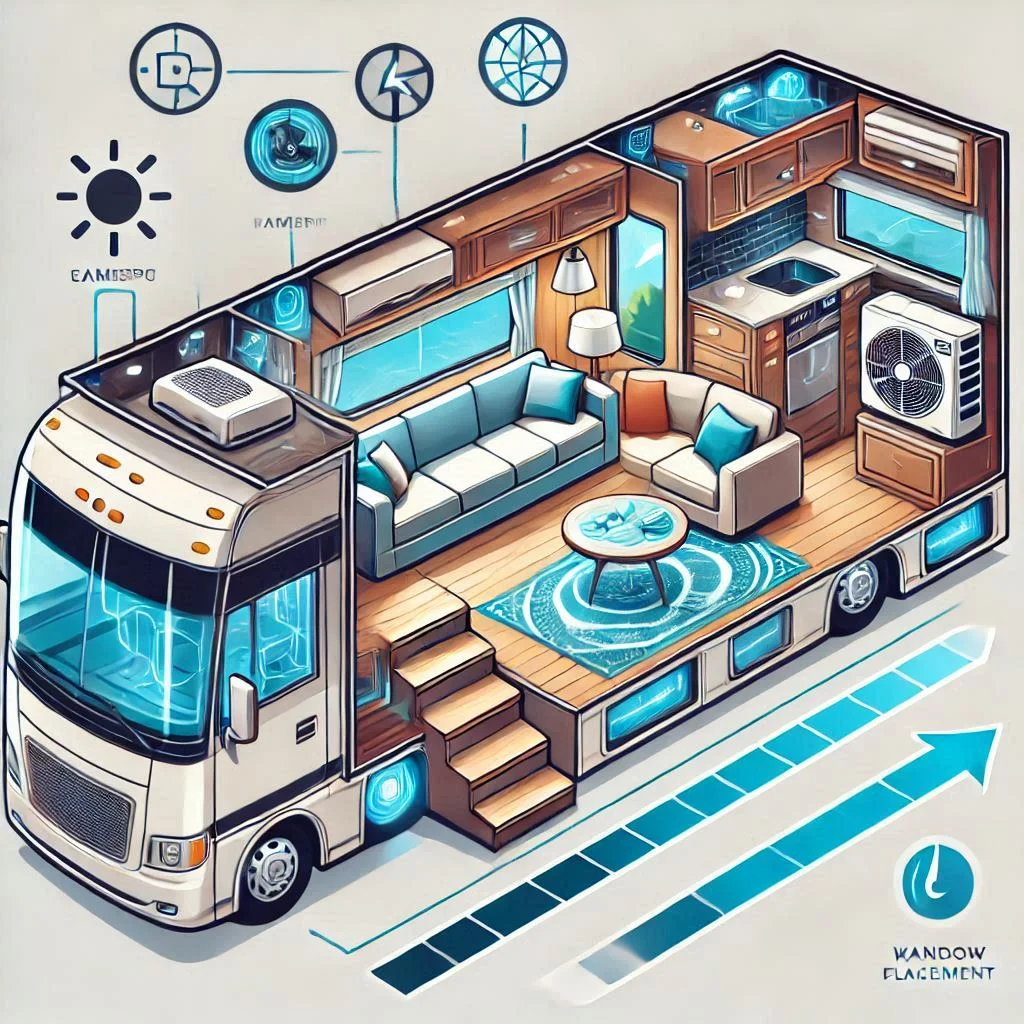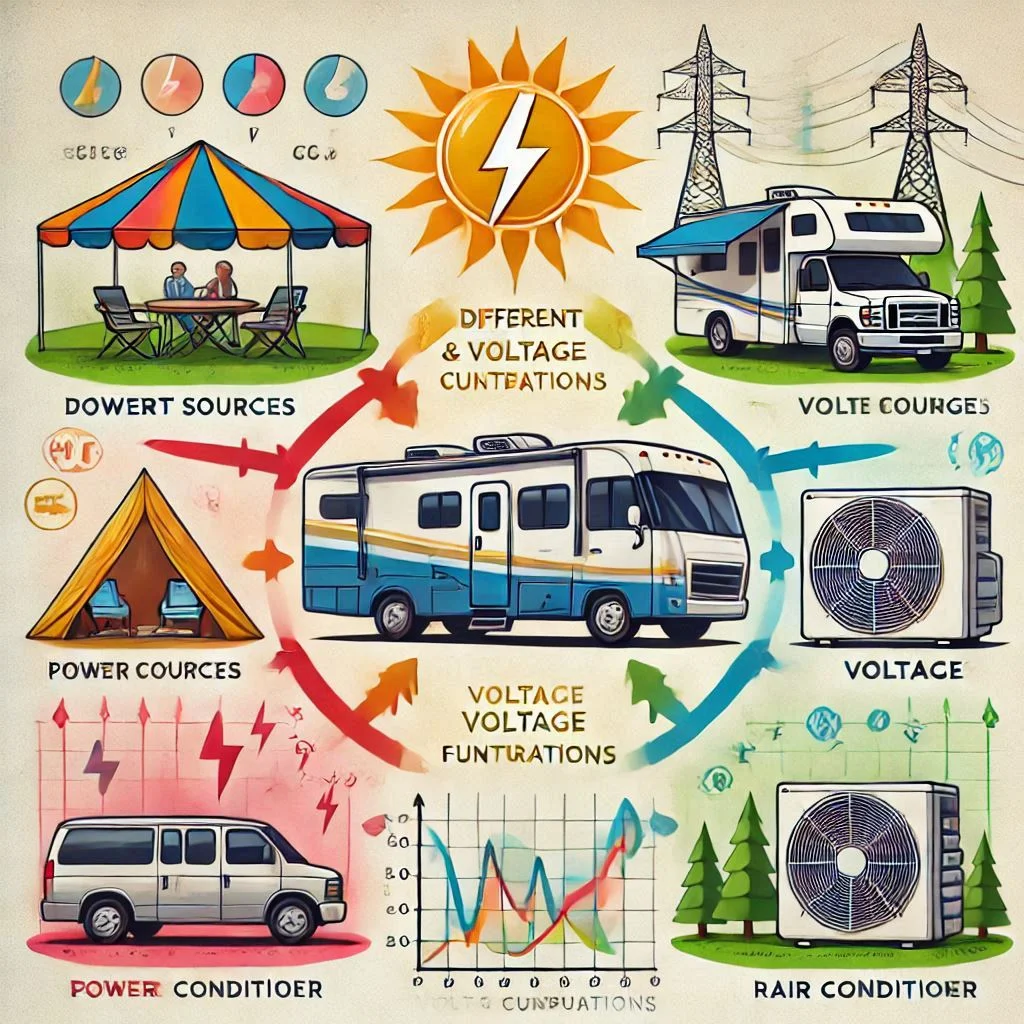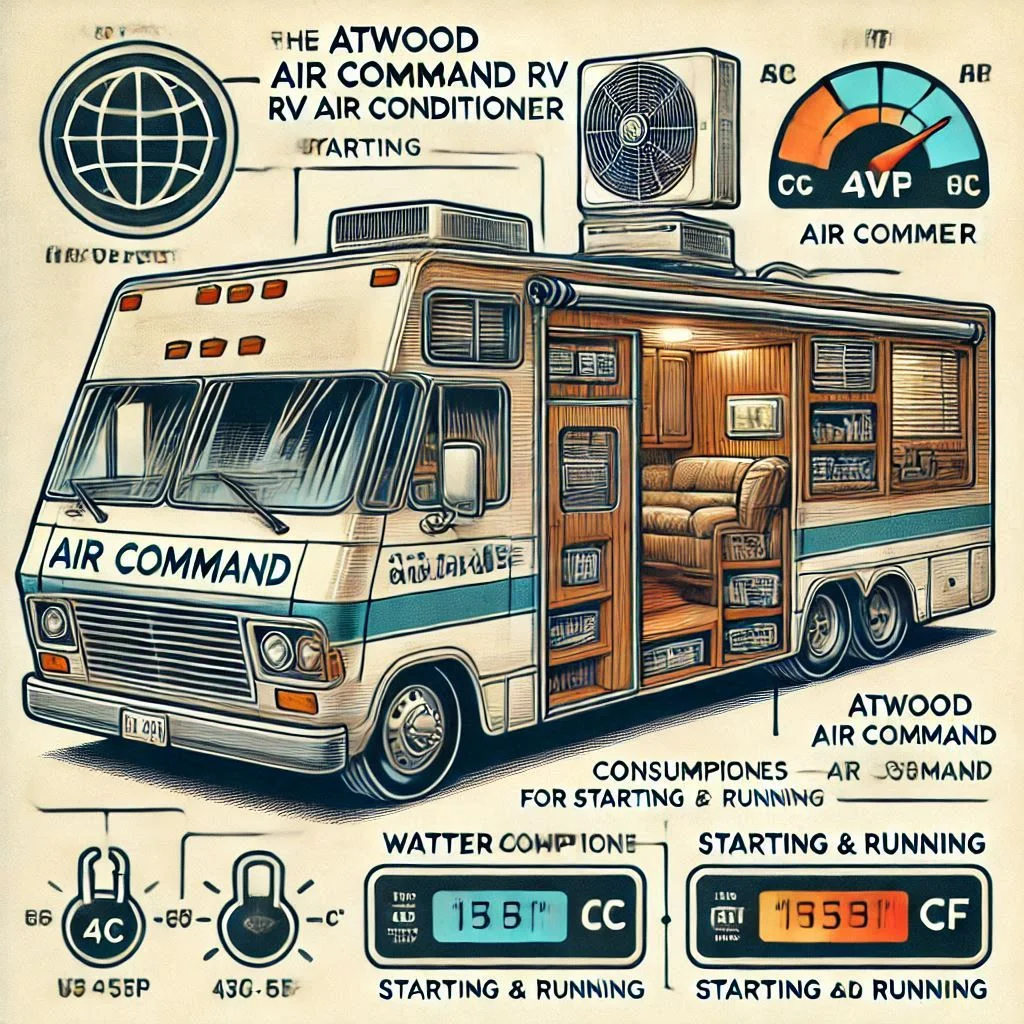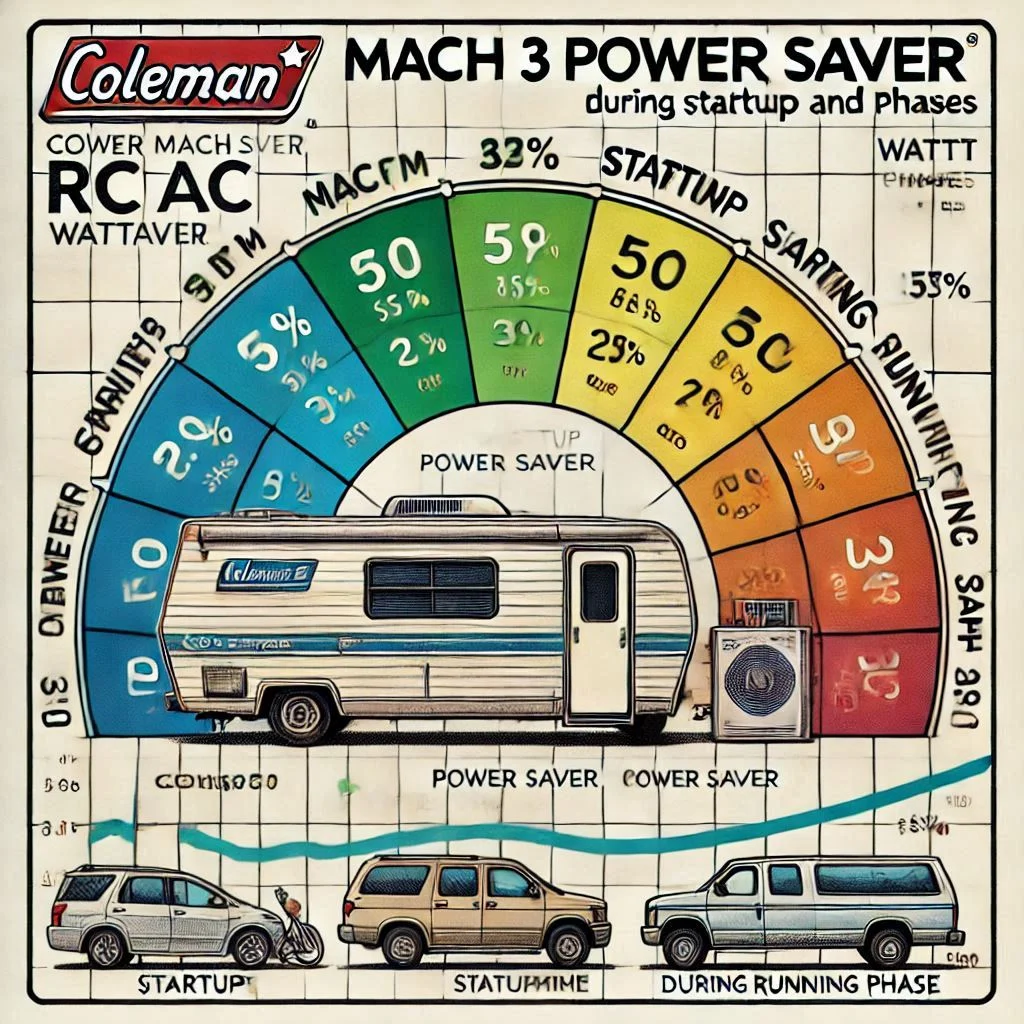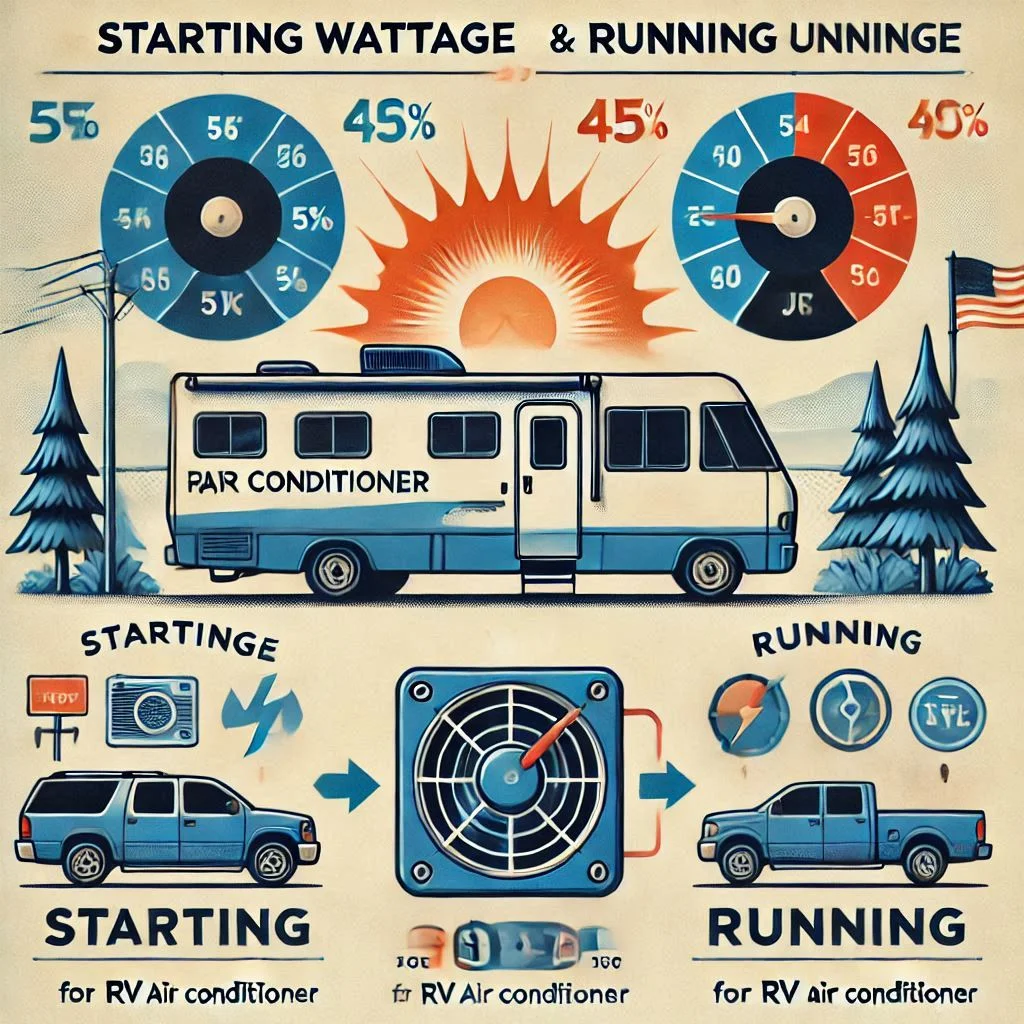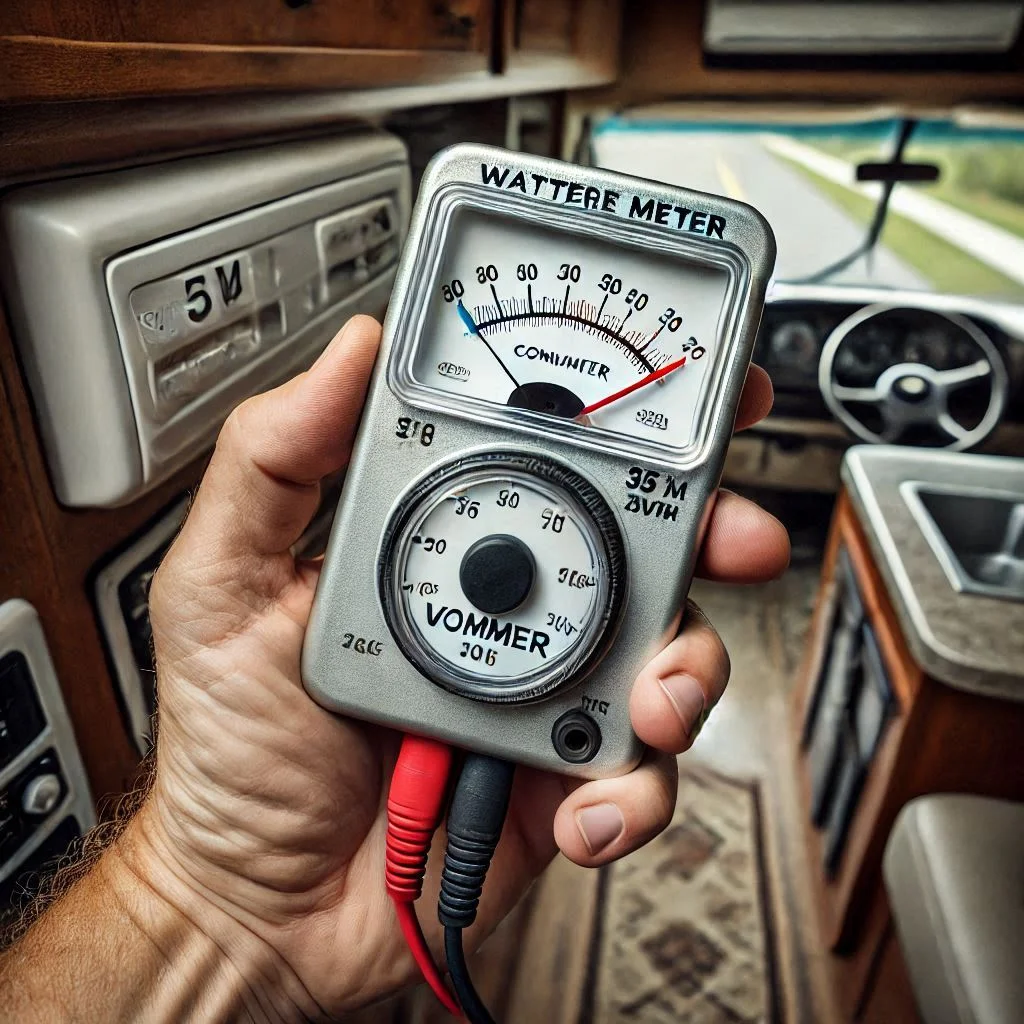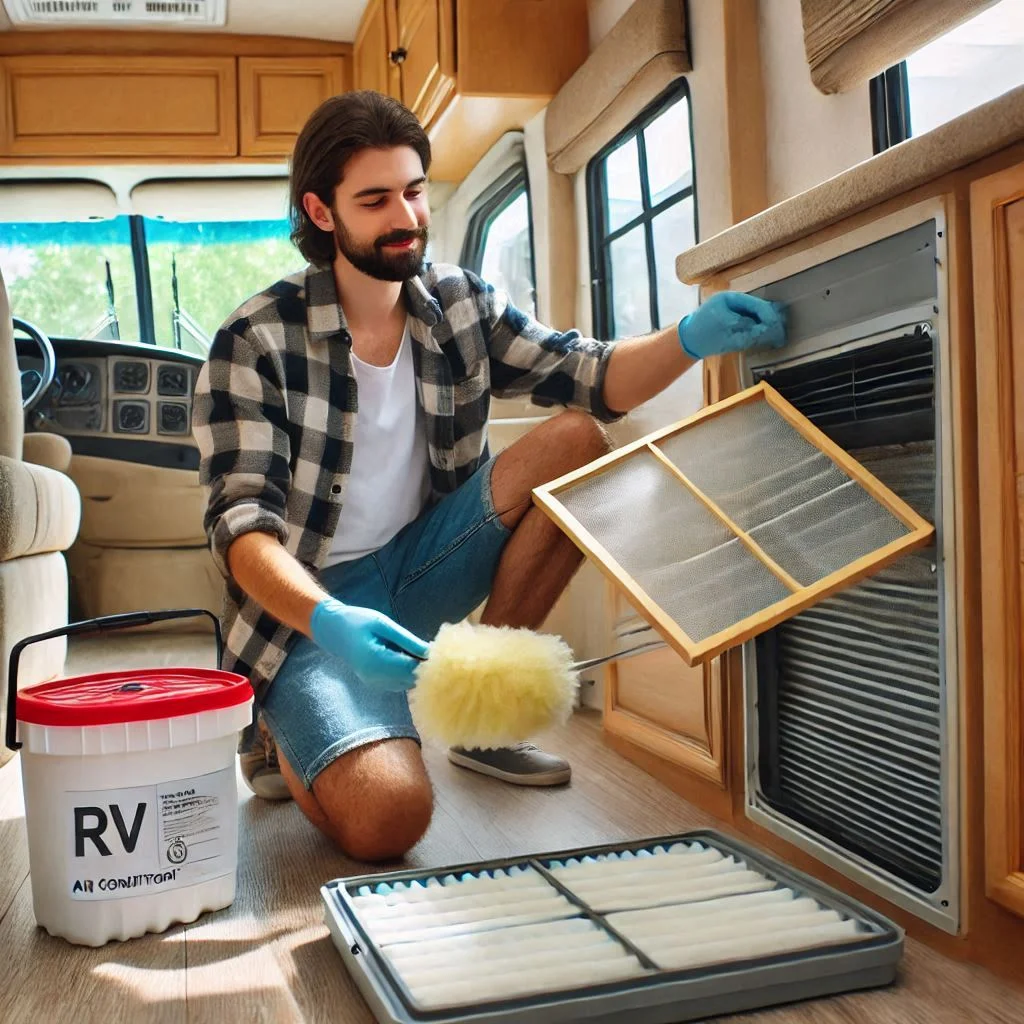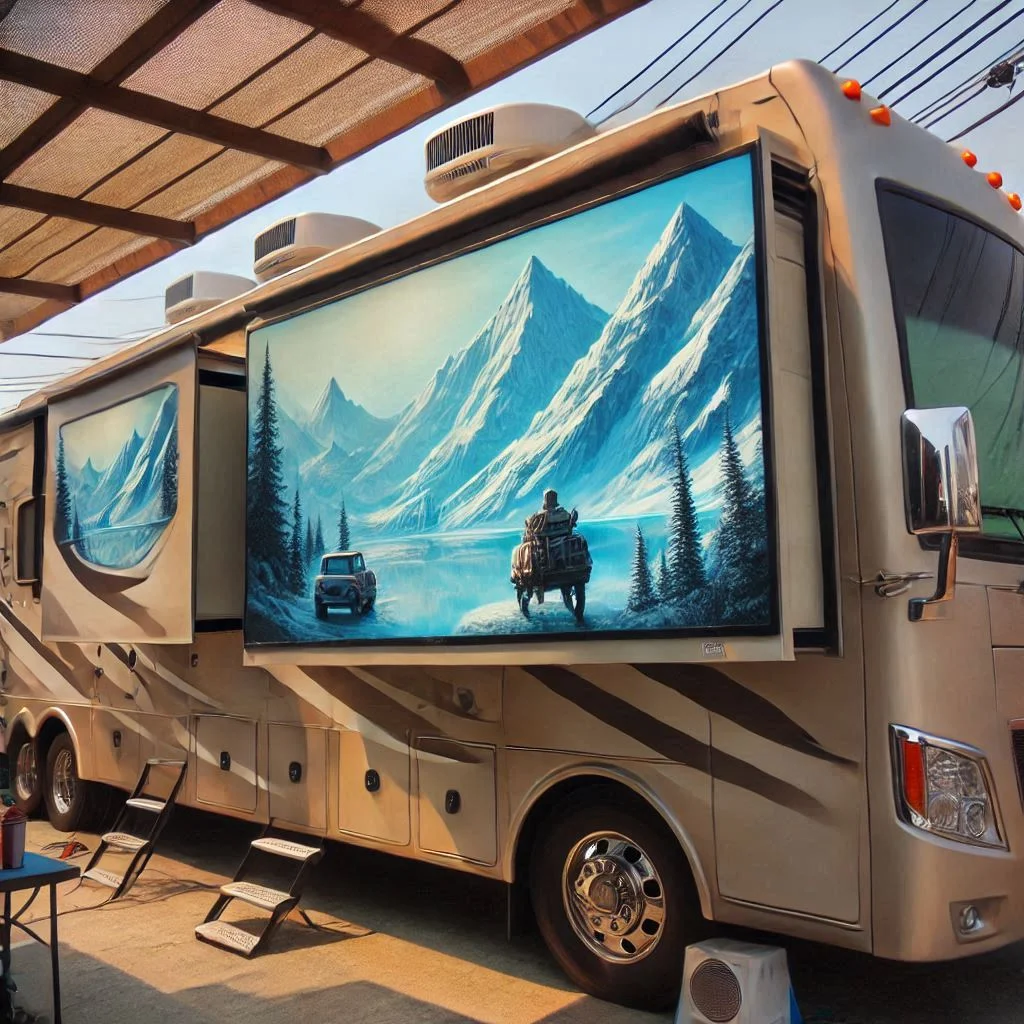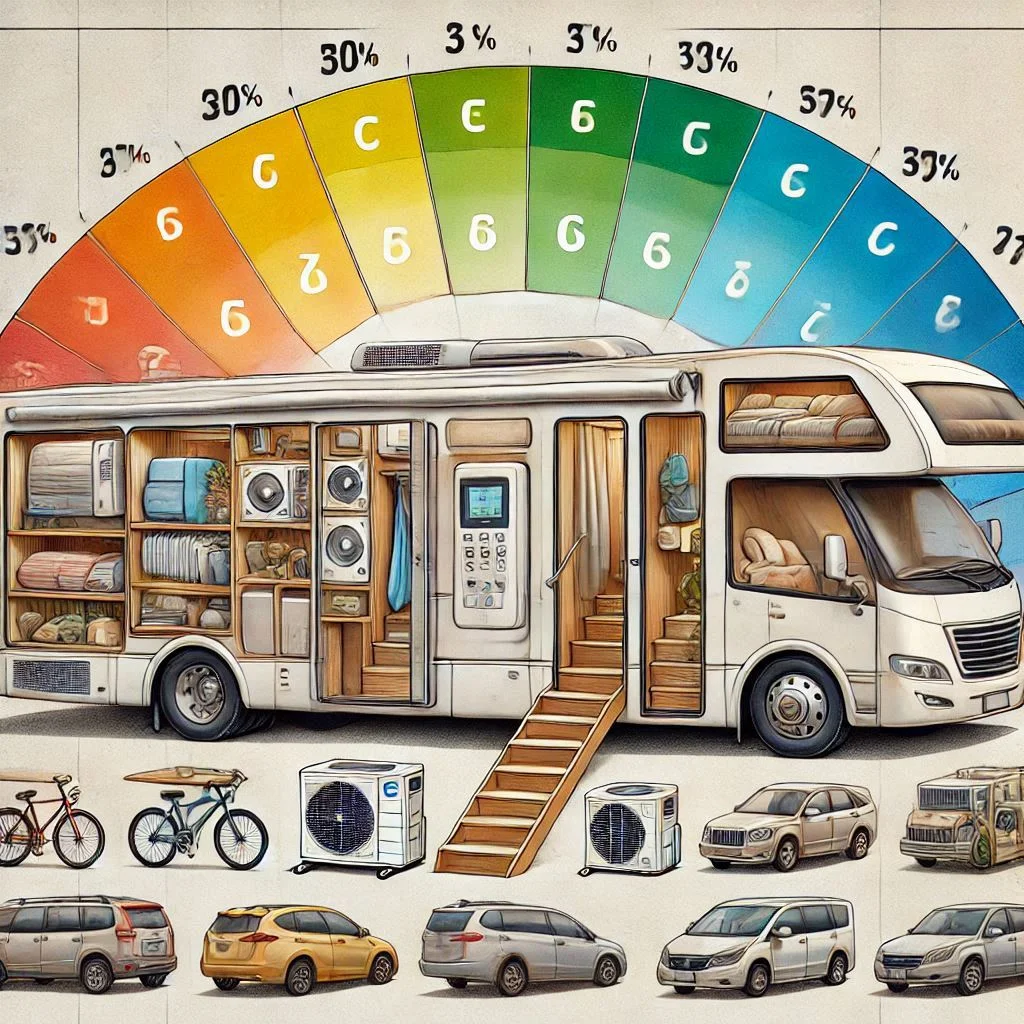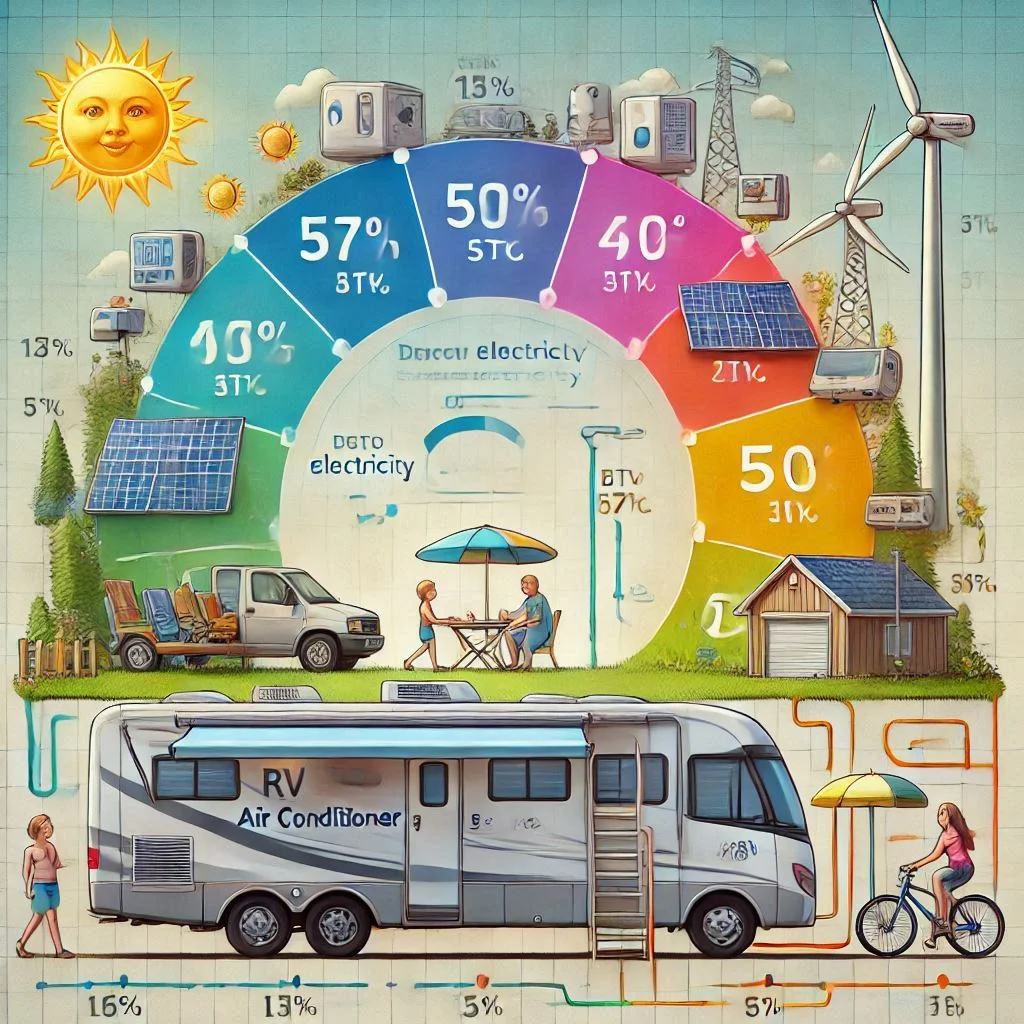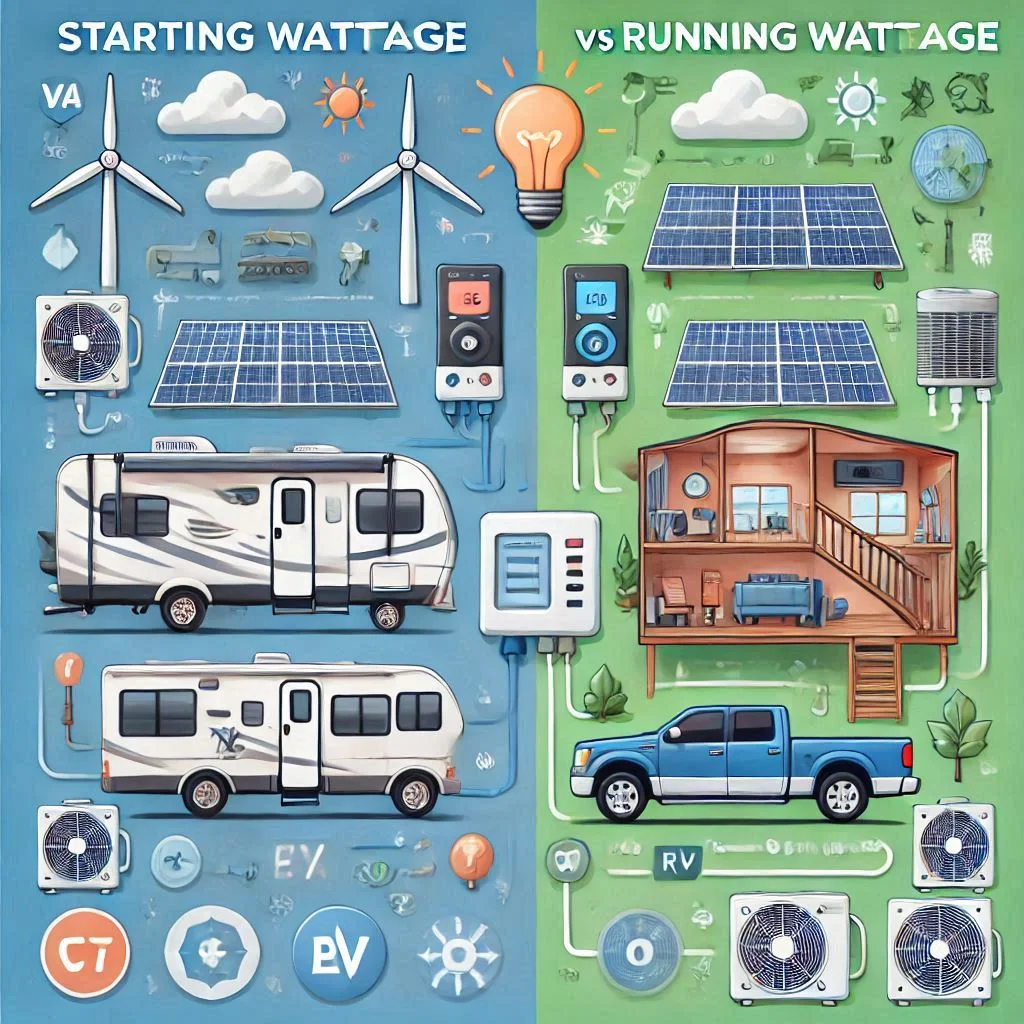How Many Watts Does An RV Air Conditioner Use?
An RV air conditioner (AC) is a vital component for keeping your living space comfortable during hot weather. However, knowing how many watts an RV AC uses is essential for making informed decisions about power consumption, generator sizing, and energy efficiency.
In general, RV air conditioners consume anywhere from 1,000 to 2,500 watts of power. However, this number can vary depending on the model, size, and external factors such as ambient temperature and the RV’s insulation. Understanding the specific wattage requirements of your RV AC will help you select an appropriately sized generator, maintain your system efficiently, and ensure that you don’t run into power issues while traveling or camping off-grid.
Key Factors Affecting Wattage:
- AC Model and Size: Larger units, typically rated at 15,000 BTUs, consume more power than smaller 10,000 BTU units.
- Efficiency of the Unit: Energy-efficient models consume fewer watts.
- Climate Conditions: Extremely hot weather may require the AC to work harder, drawing more power.
By knowing how many watts your RV AC uses, you can prevent overloading your electrical system and ensure smooth operations while on the road.
Understanding RV AC Wattages and BTUs
BTU (British Thermal Unit) is a measure of the cooling power of an air conditioning unit. It indicates how much heat an air conditioner can remove from the air in one hour. When it comes to RV air conditioners, the higher the BTU, the more powerful the unit is, and the more watts it will consume.
- Low-BTU Units: Smaller RVs or campers may use units with 8,000 to 10,000 BTUs, consuming around 1,000 to 1,200 watts.
- Mid-Range Units: For medium-sized RVs, a 13,500 BTU AC unit typically uses between 1,300 to 1,500 watts.
- High-BTU Units: Larger RVs often use 15,000 BTU units, which can consume anywhere from 1,500 to 2,500 watts or more, depending on the brand and efficiency.
It’s important to match the BTU of your air conditioner with the size of your RV. A higher BTU unit can cool larger spaces but will also require more watts to operate efficiently.
Starting Wattage vs Running Wattage
When selecting a generator or power source for your RV AC, you must consider both starting wattage and running wattage.
- Starting Wattage (also known as surge wattage) is the initial power required when the air conditioner starts. This can be significantly higher than the running wattage due to the compressor motor’s inrush current. Depending on the size of your unit, starting wattage may range from 2,000 to 3,000 watts.
- Running Wattage is the amount of continuous power the unit requires once it is running. This is typically much lower than starting wattage. For example, a 13,500 BTU RV air conditioner might require about 1,300 watts to run continuously.
Knowing both wattages is critical for selecting an appropriately sized generator or inverter system. A generator with sufficient surge power can handle the initial start-up and maintain steady operation throughout the day.
By understanding the power needs of your RV air conditioner, you can ensure you’re using the right generator or power source, avoid overloading your electrical system, and maximize energy efficiency during your RV trips.
Factors Affecting RV Air Conditioner Wattage
When it comes to selecting the right power source for your RV air conditioner (AC), several factors play a crucial role in determining the wattage it requires. These factors include the size of the RV, external environmental conditions, the quality of insulation, the layout of your RV, and the power source you’re using. Understanding how these elements affect wattage is key to optimizing your RV’s energy consumption and selecting an appropriately sized generator.
Size of the RV
The size of your RV has a direct impact on how much wattage your air conditioner will require to cool the space effectively. Larger RVs need more power to maintain a comfortable temperature because they have more volume to cool down. For instance, a smaller camper or trailer might only need a 10,000 BTU AC, which uses approximately 1,000 to 1,200 watts, while a larger motorhome with more interior space might require a 15,000 BTU unit, consuming 1,500 to 2,500 watts.
A smaller RV generally has fewer square feet to cool, so its cooling demands are lower. However, larger RVs, such as Class A motorhomes, have more space and higher heat absorption, thus requiring a higher wattage AC system to achieve the desired temperature.
Ambient Temperature and Humidity
The ambient temperature and humidity levels play a significant role in how much power your RV air conditioner will need to operate efficiently. High ambient temperatures, such as those experienced in the summer months or in hotter climates, require the air conditioner to work harder to cool the interior of the RV. Similarly, higher humidity levels can make it feel hotter inside the RV, increasing the load on the AC unit.
For example, in extremely hot environments (100°F or higher), the air conditioner must work at maximum capacity to lower the temperature, consuming more watts. Likewise, in humid climates, the AC may have to run continuously to maintain a comfortable indoor environment, thereby increasing power consumption.
Insulation Quality in the RV
The quality of insulation in your RV is another critical factor in determining how many watts your air conditioner will consume. Proper insulation helps maintain the temperature inside the RV by reducing the amount of heat that enters or escapes. Poor insulation forces the air conditioner to work harder to regulate the interior temperature, which can significantly increase power consumption.
For example, RVs with better insulation will require less cooling power, meaning the AC unit can operate at a lower wattage for the same effect. On the other hand, RVs with poor insulation or thin walls will let in more heat, requiring the air conditioner to run longer and at higher wattage to keep the temperature comfortable.
RV Layout and Design
The layout and design of your RV can affect how efficiently the air conditioner can cool the interior. RVs with open floor plans or large windows might require more cooling power because the open space allows hot air to circulate more freely. Large windows can also let in more heat from the sun, increasing the cooling load on the AC unit.
RVs with compartmentalized spaces or smaller, enclosed areas can potentially require less wattage, as the air conditioner will not have to cool as large an area. In addition, RV designs that promote better airflow and ventilation will allow the AC to cool the space more effectively, consuming less energy.
Power Source and Voltage Fluctuations
The power source you use for your RV air conditioner also impacts its wattage consumption. Whether you’re connected to shore power, using a generator, or relying on solar power, the availability and consistency of power can affect how efficiently your AC unit operates. Voltage fluctuations or unstable power can cause the air conditioner to consume more wattage to compensate for the irregular supply, leading to higher energy consumption.
For instance, running an RV AC on a generator with insufficient power output may cause the air conditioner to surge, using more wattage than necessary. On the other hand, a high-quality generator with a stable power output will provide the necessary wattage without overloading the system.
RV AC Watt Consumption for Different Models
When selecting an RV air conditioner (AC), it’s important to understand how much wattage different models consume. The wattage of your RV AC impacts your overall energy consumption, generator selection, and battery efficiency. Below, we’ll look at some popular RV AC models and their wattage consumption, along with a general overview of common RV AC unit sizes.
Atwood Air Command
The Atwood Air Command is a popular RV air conditioner known for its efficiency and high cooling power. It is designed to handle high temperatures, making it suitable for use in a variety of climates. The Atwood Air Command typically operates at 13,500 BTUs and uses approximately 1,350 to 1,500 watts of power during its running phase. It is a great choice for mid-sized RVs or campers that need reliable and efficient cooling without consuming too much power.
One key feature of the Atwood Air Command is its energy efficiency. It is designed to reduce power consumption while still providing optimal cooling performance, which is especially important for off-grid RV camping. The starting wattage of the unit can be higher than the running wattage due to the surge demand when the compressor kicks in. On average, the Atwood Air Command may require 2,000 to 2,200 watts to start.
Coleman-Mach 3 Power Saver
The Coleman-Mach 3 Power Saver is another highly efficient RV air conditioner, especially well-suited for travelers looking to reduce their energy usage while maintaining a comfortable interior temperature. This unit offers cooling capacities typically ranging from 13,500 to 15,000 BTUs, and it operates efficiently, consuming 1,300 to 1,600 watts of power while running.
The Coleman-Mach 3 Power Saver is particularly valued for its low power consumption compared to traditional RV AC models. It’s designed with a high-efficiency compressor and a low-speed fan, which reduces overall energy use. During startup, the Coleman-Mach 3 Power Saver may require around 2,000 watts to overcome the initial surge, but once it reaches a steady state, it will continue to operate at a lower wattage, making it an excellent choice for those concerned with minimizing fuel consumption.
For RVers who want a balance between power and efficiency, the Coleman-Mach 3 Power Saver is an excellent option. It is particularly beneficial for campers who often use generators or solar power systems, as it provides optimal cooling without overwhelming smaller power sources.
Common RV AC Unit Sizes and Wattage
When selecting an RV AC unit, understanding the wattage consumption for various sizes is crucial for ensuring that you can power the unit without overloading your system. Below are common RV AC unit sizes and the typical wattage they consume:
- 8,000 to 10,000 BTU Units: These smaller units are ideal for compact RVs and campers. They typically consume between 900 and 1,200 watts during operation. These models are perfect for those who do not require heavy-duty cooling but still need a reliable system to maintain comfort.
- 13,500 BTU Units: This is the most common size for RVs and is suitable for medium-sized trailers, fifth wheels, and motorhomes. They generally use between 1,300 and 1,500 watts while running. These units offer a good balance between cooling power and energy consumption.
- 15,000 BTU Units: Larger motorhomes and RVs often require a 15,000 BTU unit, which consumes between 1,500 and 2,500 watts while running. These models provide powerful cooling and are ideal for those who travel to warmer climates or for those who want faster cooling in larger RVs.
In addition to cooling capacity, it’s also important to consider the type of technology used in the AC. Newer models with inverter technology and energy-saving features consume less power while maintaining the same level of cooling efficiency.
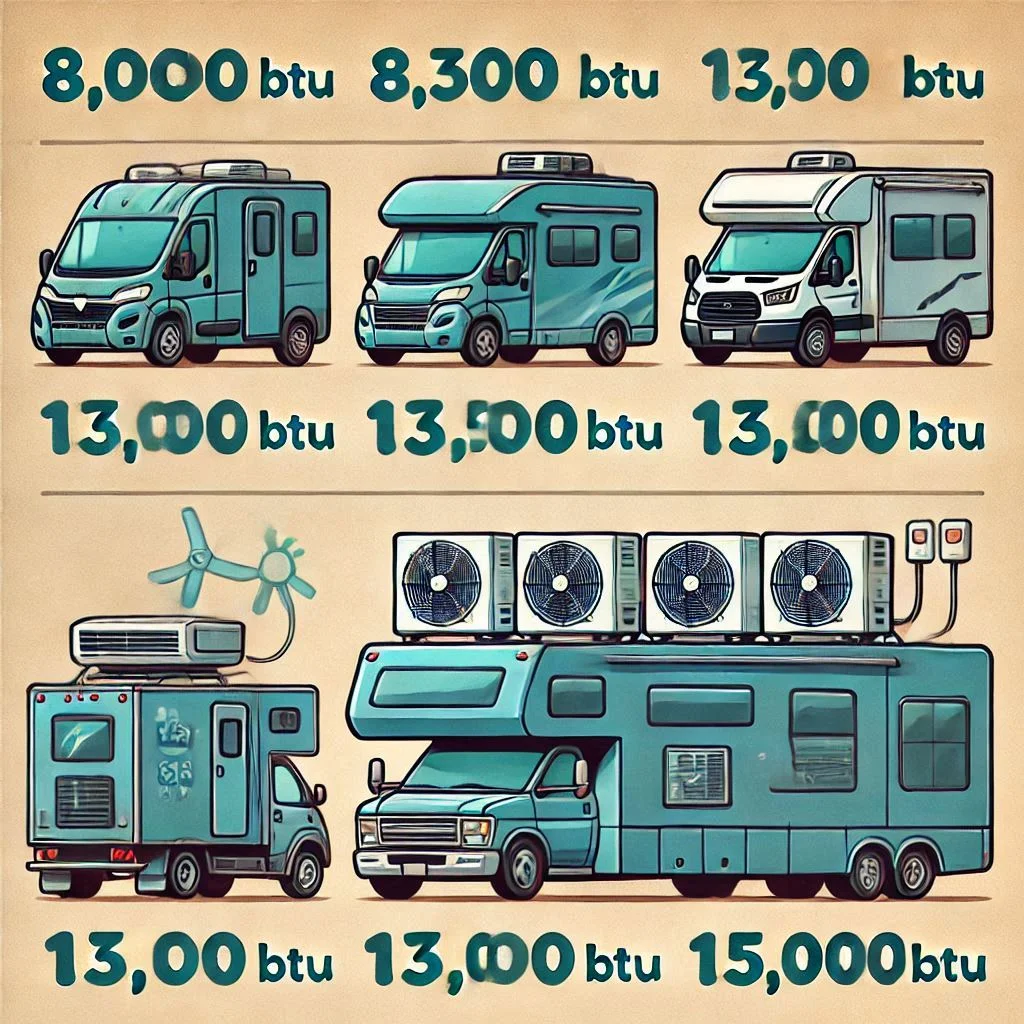
How to Calculate the Power Consumption of an RV AC
Understanding and calculating the power consumption of your RV air conditioner (AC) is crucial to optimize energy usage and ensure that you have the appropriate power source. Whether you’re using a generator, battery, or shore power, knowing how much energy your AC uses will help you avoid power overloads and ensure efficient cooling. This guide covers the essential steps to calculate your RV air conditioner’s power consumption.
Understand Power Consumption
Before diving into the calculations, it’s important to understand what power consumption means in the context of an RV air conditioner. Power consumption refers to the amount of energy an AC unit requires to function, typically measured in watts (W). It can be broken down into two key components:
- Starting Wattage: This is the surge of power required to kick-start the air conditioner, especially when the compressor starts. The starting wattage can be significantly higher than the running wattage, and it is typically needed for a brief period when the unit begins operating.
- Running Wattage: This is the amount of power the air conditioner requires to run continuously. It’s the steady-state power needed to keep the unit functioning once it has started.
The total wattage an AC uses will depend on the unit’s size (BTU rating), efficiency, and the power source it operates on.
Understanding these concepts is the first step to ensuring you have the right equipment to handle the power consumption of your RV AC.
Calculate the Wattages
To accurately calculate the power consumption of your RV air conditioner, follow these steps:
- Determine the BTU Rating of the AC: The BTU (British Thermal Unit) rating is the cooling capacity of the AC. It is typically listed in the product specifications. A higher BTU rating means the unit is capable of cooling a larger space, which often leads to higher wattage consumption.
- Convert BTU to Wattage: Use the following formula to convert the BTU rating to watts:Wattage=BTU3.412\text{Wattage} = \frac{\text{BTU}}{3.412}Wattage=3.412BTUFor example, a 13,500 BTU air conditioner will consume around:13,5003.412=3,957 watts\frac{13,500}{3.412} = 3,957 \text{ watts}3.41213,500=3,957 wattsThis is the running wattage. Remember, starting wattage will be higher than the running wattage, so you should plan for that initial surge of power when choosing your power source.
- Consider Efficiency: The efficiency of your AC unit affects its wattage consumption. More efficient models use less power for the same cooling capacity. If your unit has an energy-efficient compressor or inverter technology, it may use 20-30% less power than a non-efficient unit.
- Account for Power Loss: Ensure that you factor in any possible loss of power in the system (such as from an inverter or generator) to get a more accurate calculation of power needs.
Calculating the wattage of your RV air conditioner will give you a clear picture of how much power you need to ensure reliable operation without overloading your power system.
Using a Wattage Meter
One of the most accurate ways to measure power consumption is by using a wattage meter. This device is designed to measure the electrical power used by your RV air conditioner in real time, providing precise data on both starting and running wattages.
Here’s how to use a wattage meter to measure the power consumption of your RV AC:
- Plug the Meter into Your Power Source: Connect the wattage meter to the power supply (generator, inverter, or shore power). Make sure the meter is capable of handling the power level of your RV AC.
- Plug the AC into the Meter: After connecting the wattage meter to your power source, plug your RV air conditioner into the meter. This will allow the meter to record the wattage consumed by the AC.
- Turn On the AC: Power on your air conditioner and let it run for a few minutes. The wattage meter will measure both the starting wattage (when the compressor starts) and the running wattage (once the unit stabilizes).
- Read the Measurements: Most wattage meters display real-time data on their screens, showing you how much power your RV AC is consuming at any given moment. Take note of the highest reading during startup to account for the surge wattage.
- Repeat If Necessary: For more accuracy, you can repeat the process at different times or under varying conditions (e.g., during hot weather) to see how the power consumption may fluctuate.
Using a wattage meter is a reliable way to understand exactly how much power your RV air conditioner needs, helping you plan accordingly for generator sizing or battery capacity.
Tips to Improve RV AC Efficiency
Maintaining the efficiency of your RV air conditioner (AC) is essential for both comfort and energy savings, especially when you’re off-grid or relying on a limited power source. By optimizing the performance of your AC, you can extend its lifespan, reduce energy consumption, and enhance your overall camping experience. Here are some expert tips to help improve the efficiency of your RV air conditioner.
Clean Filters Regularly
One of the most straightforward ways to improve the efficiency of your RV air conditioner is by cleaning the filters regularly. The filters in your AC unit trap dust, dirt, and debris, preventing them from circulating in the air. However, if these filters become clogged, the airflow is restricted, causing the AC to work harder to cool the space. This can lead to increased energy consumption and potential damage to the unit.
Why Clean Filters Matter:
- Improved Airflow: Clean filters ensure optimal airflow, allowing the AC to cool your RV more effectively.
- Energy Efficiency: A clean filter reduces strain on the AC, which in turn lowers energy usage.
- Prolonged AC Life: Regular cleaning helps prevent the buildup of debris that can cause long-term wear on your AC unit.
How to Clean the Filters:
- Turn off the power to your RV air conditioner before cleaning.
- Remove the filters from the AC unit.
- Use a vacuum cleaner or rinse the filters with water to remove dirt and dust.
- Let the filters dry completely before reinstalling them.
Improve Insulation
Insulation plays a key role in improving the efficiency of your RV air conditioner. Proper insulation keeps the cool air inside and prevents hot air from entering, reducing the workload of your AC unit. Poor insulation can cause your air conditioner to work harder and use more power, especially in extremely hot or cold conditions.
Ways to Improve Insulation:
- Upgrade RV Insulation: Adding foam or reflective insulation to your RV’s walls and ceiling can significantly reduce heat gain.
- Use Insulated Doors and Windows: Make sure that doors and windows are sealed properly and consider using insulated or double-glazed windows to minimize heat transfer.
- Install Reflective Foil: Reflective foil on windows and vents can further reduce heat absorption and help maintain a comfortable temperature inside.
Improving insulation helps maintain a consistent temperature inside your RV, meaning your AC won’t have to work overtime to keep the space cool.
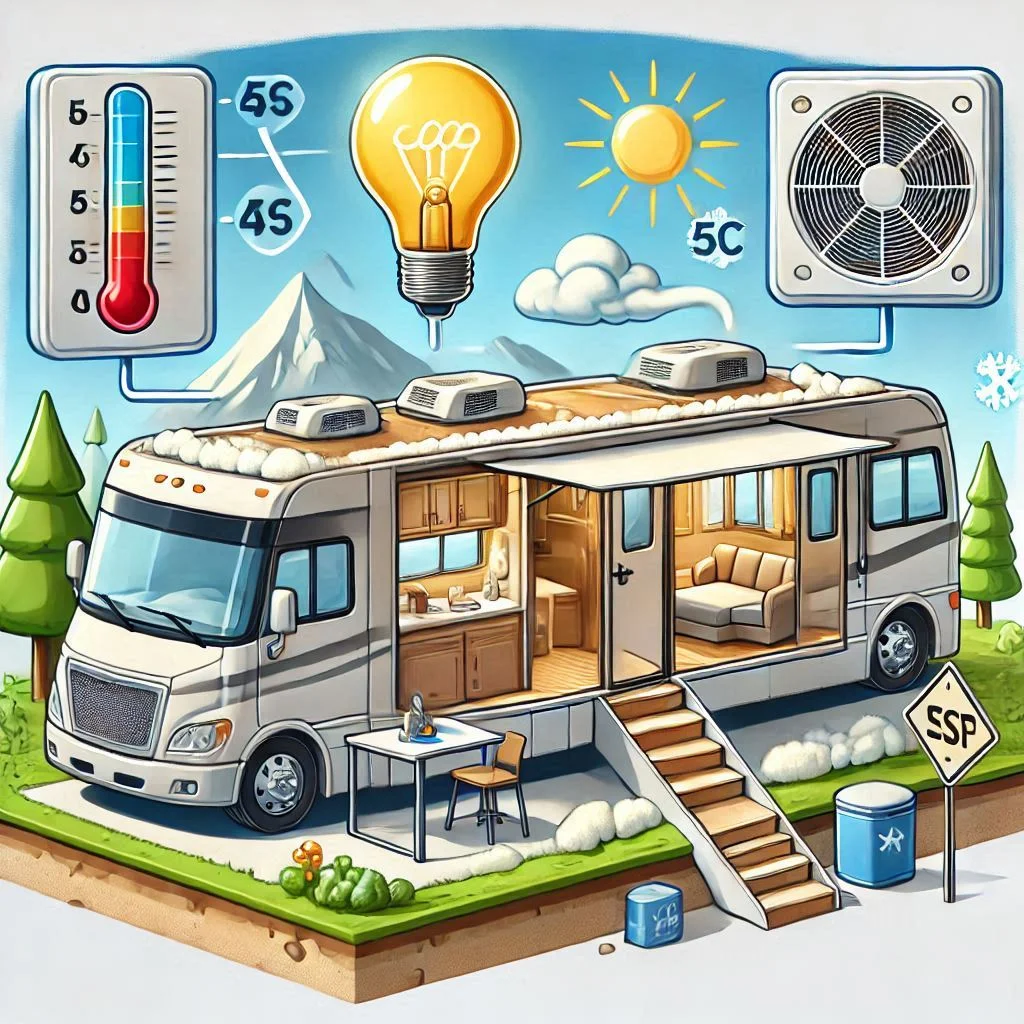
Use Shade and Reflective Covers
Shading and using reflective covers can drastically reduce the heat entering your RV, which in turn helps your air conditioner maintain a cooler temperature with less effort. The sun’s direct rays can increase the temperature inside the RV, forcing the AC to run longer and consume more power.
Effective Ways to Use Shade and Reflective Covers:
- Park in the Shade: Whenever possible, park your RV under trees or shaded areas to reduce direct sunlight on the roof and sides of your vehicle.
- Use Reflective Window Covers: Install reflective covers or shades on windows to prevent the sun’s heat from entering and to block UV rays.
- Install a Roof Shade: A roof shade or RV awning can provide additional protection from the sun’s heat, keeping your RV cooler.
By keeping your RV shaded, you’ll reduce the workload on your air conditioner and lower the overall power consumption.
Employ Additional Fans
Sometimes, relying solely on the AC for cooling may not be necessary. Using additional fans can enhance airflow and improve the cooling process inside your RV, reducing the time your air conditioner needs to operate.
Types of Fans to Consider:
- Ceiling Fans: Install a ceiling fan to help circulate cool air more evenly throughout your RV. This helps the air conditioner maintain a steady temperature while using less power.
- Portable Fans: Small, portable fans placed near the AC or in the hottest spots inside the RV can assist with airflow and reduce the demand on your air conditioner.
- Exhaust Fans: Ventilate hot air out of the RV by using exhaust fans or vents, especially in areas like the kitchen or bathroom.
Using fans alongside your AC unit helps to circulate cool air more effectively, allowing your air conditioner to work less, thus saving energy.
Optimize Thermostat Settings
Setting your thermostat to an optimal temperature can greatly improve the efficiency of your RV air conditioner. A small change in thermostat settings can reduce the strain on your AC and result in lower energy consumption.
Tips for Optimizing Thermostat Settings:
- Set the Thermostat Higher: If you’re comfortable with a slightly warmer temperature, set the thermostat a few degrees higher (e.g., 78°F instead of 72°F). Each degree increase can significantly lower energy use.
- Use a Programmable Thermostat: A programmable thermostat can help you maintain the desired temperature while minimizing energy waste. Set it to adjust based on your schedule, ensuring that the AC isn’t running unnecessarily when you’re not inside.
- Avoid Frequent Adjustments: Constantly changing the thermostat can cause the AC to work harder. Set it at your preferred temperature and let it stabilize.
FAQs About RV Air Conditioner Wattage
When it comes to understanding the wattage and energy consumption of RV air conditioners, many RV owners have similar questions. This FAQ section addresses the most common queries and provides valuable insights to help you better manage your RV air conditioning system, optimize energy use, and make more informed decisions.
What is the Average RV Air Conditioner Energy Consumption?
The average RV air conditioner typically consumes between 1,200 to 2,000 watts of electricity per hour, depending on several factors like the model, size, and environmental conditions. Generally, the larger and more powerful the AC, the higher its energy consumption.
Factors Affecting Energy Consumption:
- AC Size: A larger unit will use more energy to cool a bigger space.
- Insulation: Better-insulated RVs retain cool air better, reducing energy consumption.
- External Temperature: Hotter climates require more power to cool the RV efficiently.
Understanding the typical energy consumption can help you choose the right AC model and estimate your energy needs when planning trips off-grid or with a limited power supply.
How Much Electricity Does an RV Air Conditioner Use?
An RV air conditioner uses electricity based on its wattage and the duration of use. On average, an RV AC uses 1,200 to 2,500 watts per hour. However, this can vary depending on the cooling power (BTUs), the efficiency of the unit, and external factors such as weather conditions.
Electricity Usage Breakdown:
- Small Units (5,000-8,000 BTU): Typically consume around 1,200 watts per hour.
- Medium Units (9,000-13,500 BTU): Use approximately 1,500-2,000 watts per hour.
- Large Units (14,000-18,000 BTU): Can consume between 2,000-2,500 watts per hour.
Understanding this energy consumption is crucial when choosing the right power source, whether it’s a generator, solar setup, or grid power.
How Much Power Does an RV Air Conditioner Use Per Hour?
The amount of power an RV air conditioner uses per hour varies with its BTU rating, efficiency, and operating conditions. On average, you can expect an RV AC to draw between 1,200 and 2,500 watts per hour when running continuously.
However, it’s important to note that air conditioners often use more power when starting up (known as starting wattage) compared to when they’re running continuously (called running wattage). The starting wattage can be two to three times higher than the running wattage, so it’s crucial to have a generator that can handle peak wattage requirements.
Example Breakdown:
- 5,000 BTU Unit: Consumes 1,200 watts per hour when running.
- 13,500 BTU Unit: Consumes about 1,500-2,000 watts per hour.
Understanding these details will help you select an appropriate power source and manage power consumption effectively during your RV trips.
How Many Watts Does a Portable AC Use?
A portable air conditioner used in an RV consumes power based on its size and cooling capacity. Portable AC units typically use between 1,000 and 1,500 watts per hour for a 6,000-10,000 BTU unit.
Portable AC units are a good alternative for those who need a temporary solution or want to cool specific areas in the RV, but they tend to consume more power than traditional rooftop RV air conditioners for similar cooling capabilities.
Portable AC Power Consumption Details:
- 6,000-8,000 BTU: Uses about 1,000-1,200 watts per hour.
- 9,000-10,000 BTU: Uses about 1,300-1,500 watts per hour.
Conclusion:
In conclusion, understanding the wattage and energy consumption of your RV air conditioner is essential for optimizing both comfort and energy efficiency during your travels. Whether you’re calculating the power usage of your RV AC unit, choosing the right generator, or exploring ways to improve efficiency, knowing how many watts your system consumes will help you make informed decisions. From the starting wattage to the running wattage and the role of environmental factors, there are several key aspects to consider. By following the tips provided, such as maintaining clean filters, improving insulation, and utilizing energy-efficient practices, you can maximize the performance of your RV air conditioner while reducing your energy costs. Armed with this knowledge, you’ll be able to enjoy your RV experience with confidence, ensuring that your AC system works seamlessly no matter where your adventures take you.


